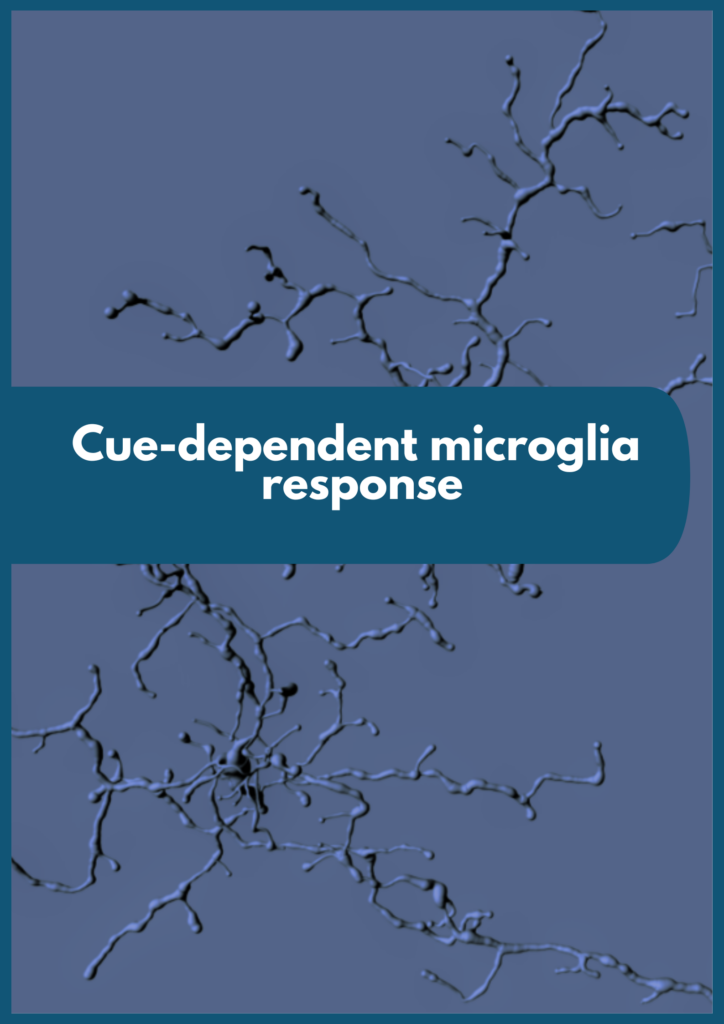
Last updated: Oct 2024
Cue-dependent microglia response
Research in the microglia field has mainly focused on resolving microglia-neuron interactions during development and disease. Our knowledge of microglia in adulthood is limited, even though they are constantly exposed to environmental cues and regularly interact with synapses. We became interested in our initial question: how do anesthetics influence microglia when the overall brain activity is lowered to a minimum?
The extracellular matrix (ECM) landscape is a critical component. The ECM surrounds the cellular landscape of the brain and can be broadly divided into the defined rigid perineuronal net (PNN), which encloses soma and proximal neuronal processes, and the diffuse perisynaptic ECM ECM composition profoundly influences the induction and consolidation of synaptic plasticity and homeostasis The PNN can sterically restrict spine formation and receptor movement, and enhance fast-firing properties due to an altered electrical charge. Microglia are known to express modulators involved in the ECM proteolytic pathway. This expression could be simply due to their surveillance function, requiring local disassembling of the ECM to pass their processes through, or representing targeted intervention to guarantee neuronal network functionality for performing homeostatic plasticity.
This paper shows that the definition of general anesthesia of being drug-inducible and fully reversible is not guaranteed with repeated exposure to ketamine anesthesia. Microglia initiate the remodeling of a widespread remodeling of the perineuronal net (PNN), a specialized extracellular matrix compartment limiting synapse adaptation. Ketamine anesthesia reinstates juvenile plasticity. Selective 60-Hz light entrainment causes a similar microglia-mediated PNN removal.
Also check out the selected community awareness:
- Wu L and Bosco D: Faculty Opinions Recommendation of [Venturino A et al., Cell Rep 2021 36(1):109313]. In Faculty Opinions, 26 Aug 2021; https://facultyopinions.com/prime/740425005
- https://www.alzforum.org/news/research-news/not-just-alzheimers-microglia-sculpt-brain-health-and-disease
- https://www.lucid.news/could-ketamine-restore-child-like-brain-plasticity-and-learning/
Microglia dismantle mature perineuronal nets upon anesthetic ketamine exposure or 60-Hz light entrainment in the healthy brain
This protocol details the strategies to perform perirneuronal net disassembly with ketamine anesthesia and 60-Hz light entrainment and a step-by-step image analysis protocol for quantifying PNN inside microglial CD68.
Minimally-invasive methods and quantification for microglia-mediated perineuronal net disassembly
Venturino A, Siegert S, “Minimally-invasive methods and quantification for microglia-mediated perineuronal net disassembly”, STAR Protocols, 2021; 2(4); 101012, https://doi.org/10.1016/j.xpro.2021.101012
The subsequent discovery of 60-Hz light entrainment recapitulating a similar phenotype as with ketamine anesthesia initiated an IP.
On-going:
- Sex-specific difference in microglia response upon acute ketamine exposure.
- Microglia involvement in temporal fine-tuning of visual information processing in retinal neuronal circuits.
- Crossing bridges between experimental and computational neuroscience in exploring theoretical models to identify how neuronal network dynamics change across conditions and time and how this effects animal behavior.